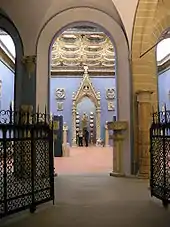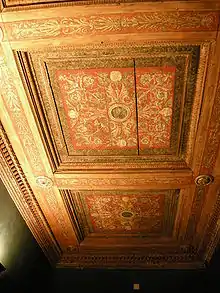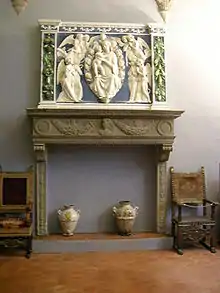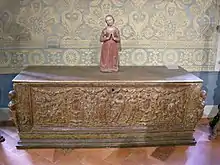Stefano Bardini
Stefano Bardini (1836–1922) was an Italian connoisseur and art dealer in Florence who specialized in Italian paintings, Renaissance sculpture, cassoni and other Renaissance and Cinquecento furnishings and architectural fragments that came on the market during the urban regeneration of Florence in the 1860s and 70s.[1]

Trained as a painter and expert copyist at the Accademia di Belle Arti Firenze from 1854,[2] Bardini received increasing commissions as a restorer and expanded into selling works of art from 1870 onwards.[3][4][5]

Working as a restorer Bardini, who successfully removed some Botticelli frescoes from the Villa Lemmi, was commissioned to remove the frescoes commissioned by Jakob Salomon Bartholdy from several of the German Nazarene circle of painters from Casa Bartholdy, Rome, which had been purchased by Berlin, in 1886–87.[6] His esthetic, barely distinguishable restoration of Simone Martini's Saint Catherine of Alexandria, now in the National Gallery of Canada, has been examined as an outstanding example of the seamless restorations that his generation preferred.[7]
Many well-known works of Renaissance art bear a Bardini provenience. The National Gallery of Art, Washington DC, has some twenty works that passed through his hands,[8] notably the Benedetto da Maiano Madonna and Child, the Bernardo Daddi Saint Paul and the Portrait of a Youth by Filippino Lippi. The Metropolitan Museum of Art conserves eight paintings that Bardini once owned, including Veronese's Boy with a Greyhound,[9] and Giovanni di Paolo's Coronation of the Virgin from the Robert Lehman collection, as well as the baroque portrait bust of Ferdinando de' Medici by Giovanni Battista Foggini and an eagle lectern by Giovanni Pisano.[10] Bardini's connections with Bernard Berenson resulted in several of Bardini's purchases finding their way to the Isabella Stewart Gardner Museum, Boston, where Berenson was the guiding light; among them are two North Italian Romanesque stylobate, column-supporting lions and a basin, purchased from Bardini in 1897.[11] The much-damaged marble of a curly-haired youth from the Borghese collection originally belonged to Bardini,[12] later employed by Stanford White as a fountain figure in the Payne Whitney House at 972 Fifth Avenue, New York City, remaining in situ as the house was bought for the French Cultural Services, making headlines in 1996 when it was attributed as a youthful work of Michelangelo.[13] Bardini acted as White's mainstay in Florence for panelling, paintings, sculpture, and Renaissance furnishings,[14] supplying White with two 16th-century wooden ceilings reinstalled in Whitney's palazzo [15] along with other caseloads of works of art he shipped across the Atlantic to White.

In the decades after 1860 he was also responsible for the transformation of many painted cassone panels that had been previously removed from the furniture, which was considered valueless, by creating new carved and part gilded walnut cassoni in the pristine condition that was required of furniture for grand houses.[16] Of such cassoni, the quantity that came onto the market were astonishing: the German art historian Paul Schubring was shown an outbuilding, probably at Bardini's Torre del Gallo, that consisted of a single room in which he counted some 200 cassoni.[17] The archives of the Museo Bardini[18] make it clear that the free restorations and adaptations and imitations sold by Bardini were not misattributed; "confusion set in only half a century later when the heirs of the original owners came to sell the pieces," Ellen Callmann observes.[19] Not all Bardini's cassoni were heavily restored: the famous cassone painted with The Conquest of Trebizond from Palazzo Strozzi, with Strozzi armorial bearings, one of the minority of cassone panels remaining integral to its cassone, is conserved at the Metropolitan Museum of Art.[20]
In 1881 Bardini acquired the deconsecrated church and convent of San Gregorio facing piazza dei Mozzi in the Oltrarno and set about transforming it into his opulent residence and restoration studio, Palazzo Bardini, now housing the Museo Bardini, with his collections of paintings, sculpture, most notably a marble Charity by Tino da Camaino, 15th- and 16th-century Italian furniture, ceramics, tapestry, arms; stringed and keyboard musical instruments, including one of only two surviving oval spinets by Bartolomeo Cristofori; Roman and Etruscan antiquities and 15th- and 16th-century architectural fittings, including paneled and painted ceilings, chimneypieces and door surrounds.[21] His example inspired his most successful protégé, Elia Volpi, to purchase and freely restore Palazzo Davanzati in the heart of Florence, and fill it with a similar range of art.
Bardini's extensive connections among impecunious patricians and with dealers and restorers opened many avenues for acquiring works of art. Works of art from the Giampietro Campana collection, dispersed in 1858, later passed, probably indirectly, through Bardini's hands.[22] In 1892 Bardini was commissioned to oversee the dispersal of a major part of the Borghese Collection in Rome. In the spring of 1892 Bardini prepared a lavish catalogue for an auction sale of pieces from his own collection, held at Christie's.[23]
In 1902 he purchased the Torre del Gallo at Pian de' Giullari, in the hills of Arcetri, on top of a ridge with a panoramic view over the city. There he undertook neo-medieval restorations that were carried out between 1904 and 1906.
In winding down his activities, Bardini organized a sale in New York in 1918 that dispersed his sculpture and furniture into American private collections, and which eventually came to American museums.[24] Among the works was a polychromed terracotta of the Virgin and Child that remains firmly attributed to Donatello, "in the small class of autograph Donatello reliefs", as John Pope-Hennessy observed.[25] Lot 427 in the sale was of two Polyclitan marble fragments, a Diadoumenos torso associated with a head possibly of Hermes, both fine Roman copies: they are now in the Walters Art Museum, Baltimore.[26]
His bequest to the city of Florence resulted in the opening of the Museo Bardini in 1923; the Giardino Bardini across from it is also his legacy.
The recent work of Lynn Catterson has corrected much of the often repeated urban legend about Bardini. See Lynn Catterson, “Stefano Bardini, His Conservative Side and the Protection of Frescoes,” in Stefano Bardini ‘estrattista;’ affreschi staccati nell’Italia Unita fra antiquariato, collezionismo e musei, Luca Ciancabilla and Cristiano Giometti, eds, Edizioni ETS Pisa, 2019, pp. 79–92. Lynn Catterson, "Art Market, Social Network and Contamination: Bardini, Bode and the Madonna Pazzi Puzzle,” in Lynn Catterson, ed, Florence, Berlin and Beyond: Social Network and the late 19C Art Market, The Netherlands: Brill, 2020. https://brill.com/view/title/56528 Lynn Catterson, “Duped or Duplicitous? Bode, Bardini and the many Madonnas of South Kensington,” Journal of the History of Collections, Spring 2020. Lynn Catterson, “From visual inventory to trophy clippings: Bardini & Co. and the use of photographs in the late 19C art market,” from the conference, The Art Market in Italy Around 1900: Actors, Archives, Photographs / Il mercato dell'arte in Italia intorno al 1900. Protagonisti, archivi, fotografie, (Florence, Kunsthistorisches Institut in Florenz - Max-Planck-Institut and Fondazione Federico Zeri, Bologna, 14–15 November 2017), Mitteilungen des Kunsthistorischen Instituts in Florenz,” Summer 2020. Lynn Catterson, “From Florence to London to New York: J.P. Morgan’s Bronze Doors,” Nineteenth-Century Art Worldwide, 2017, vol. 16, no. 3, Autumn; “Addendum,” vol. 18, no. 1, 2019 (both freely available online). Lynn Catterson, “Stefano Bardini & the Taxonomic Branding of Marketplace Style. From the Gallery of a Dealer to the Institutional Canon,” in eds. Melania Savino, Eva-Maria Troelenberg. Images of the Art Museum, Connecting Gaze and Discourse in the History of Museology, (selected papers from the conference, Images of the Art Museum: Florence, 26–28 September 2013, Kunsthistorisches Institut in Florenz-Max-Planck-Institut) Berlin: de Gruyter GmbH, 2015, pp. 41–64. Lynn Catterson, “Stefano Bardini: Forming the Canon of Fifteenth-Century Italian Sculpture,” CENTER35, National Gallery of Art Center for Advanced Study in the Visual Arts, Record of Activities and Research Reports, June 2014 -May 2015, Washington, 2015, pp. 60–63. Lynn Catterson, “American collecting, Stefano Bardini & the Taste for TreQuattrocento Florence,” Discovering the Italian Trecento in the 19th Century, dedicated issue of Predella.it, 2017 n.41-42 (freely available online). Lynn Catterson, Editor and Introductory essay, Dealing Art on Both Sides of the Atlantic, 1860 to 1940, The Netherlands: Brill, 2017 (some chapters on Google Books).
Notes
- The art scene in Florence at this time is surveyed in three articles by John Fleming, "Art dealing and the Risorgimento", The Burlington Magazine 115 (1973:4-16); 121 (1979:492-508); 121 (1979:568-80).
- Cathleen Hoeniger, "The Restoration of the Early Italian "Primitives" during the 20th Century: Valuing Art and Its Consequences" Journal of the American Institute for Conservation 38.2 (Summer 1999:144–161), "A treatment by Stefano Bardini in the 1870s", p. 148f.
- Ellen Callmann, "William Blundell Spence and the Transformation of Renaissance Cassoni", The Burlington Magazine 141 No. 1155 (June 1999:338–348) p. 348
- Anita Moskowitz, "Stefano Bardini--the Early Years", Studi Trentini -- Arte, 2, 2013, 267-288.
- Anita Moskowitz, Stefano Bardini, "Principe degli Antiquari" - Prolegomenon to a Biography, Florence: Centro Di, 2015.
- Robert McVaugh, "A Revised Reconstruction of the Casa Bartholdy Fresco Cycle", The Art Bulletin 66.3 (September 1984:442–452).
- Hoeniger 1999 "A treatment by Stefano Bardini in the 1870s", p. 148f.
- Collection, National Gallery of Art: Stefano Bardini provenance
- Metropolitan Museum of Art: Boy with a Greyhound.
- Metropolitan Museum of Art database: search "Stefano Bardini".
- Walter Cahn, "Romanesque Sculpture in American Collections. IV. The Isabella Stewart Gardner Museum, Boston" Gesta 8.2 (1969:47-62) illus pp 52–54.
- Kathleen Weil-Garris Brandt, "More on Michelangelo and the Manhattan Marble, The Burlington Magazine 139 No. 1131 (June 1997:400–404).
- Kathleen Weil-Garris Brandt, "A Marble in Manhattan: The Case for Michelangelo" The Burlington Magazine 138 No. 1123 (October 1996), pp. 644–659; the piece had been attributed to Michelangelo by Bardini at the time of his Christie's sale, 1892, but had subsequently disappeared. James David Draper, "Ango after Michelangelo" The Burlington Magazine 139 No. 1131 (June 1997:398-400) confirmed the Michelangelo attribution.
- Wayne Craven, Stanford White: decorator in opulence and dealer in antiquities 2003: passim.
- Wayne Craven, Gilded Mansions: Grand Architecture and High Society 2009:281f.
- Callmann 1999:341f.
- Schubring, Cassoni, Truhen und Truhenbilder der italienischer Früherenaissance (Leipzig, 1923 supplement), noted in Callmann 1999:342.
- Catalogue of the Museo Bardini, Fiorenza Scalia and Cristina de Benedictis, Il Museo Bardini a Firenze (Milan, 1984); the introduction assesses Bardini's reputation; the museum director Wilhelm von Bode mentions Bardini repeatedly in his autobiography, Mein Leben (Berlin, 1930); his purchases from Bardini form the nucleus of Berlin's collection of Renaissance bronze plaquettes (Volker Krahn, "Wilhelm von Bode und die italienische Skulptur. Forschen, Sammeln, Präsentieren" Jahrbuch der Berliner Museen 34 [1992:105–119] p. 107).
- Callmann 1999:348.
- Helmut Nickel, "Two Falcon Devices of the Strozzi: An Attempt at Interpretation", Metropolitan Museum Journal 9 (1974:229–232). For images of the cassone, see "Marco del Buono Giamberti and Apollonio di Giovanni di Tomaso: Cassone with the Conquest of Trebizond (14.39)", in Heilbrunn Timeline of Art History (New York: The Metropolitan Museum of Art, 2008).
- Touring Club Italiano, Firenze e dintorni (Milan, 1964:376-79).
- W.L. Hildburgh, "A marble relief attributable to Donatello and some associable stuccos", The Art Bulletin, 30.1 (March 1948:11–19).
- Catalogue des objets d'art, antiques, du Moyen Age et de la Renaissance, provenant de la collection de Stefano Bardini, Florence Christie's, London, 26–30 May 1902
- Catalogue of the Beautiful Treasures and Antiquities illustrating the Golden Age of Italian Art belonging to the famous expert and antiquarian Stefano Bardini of Florence, Italy, American Art Association, New York, 23–28 April 1918.
- John Pope-Hennessy, "A terracotta 'Madonna' by Donatello", The Burlington Magazine 125 No. 959 (February 1983: 83–66).
- Acc. nos. 23.224, 23.225; Dorothy Kent Hill, "Polykleitos: Diadoumenos, Doryphoros and Hermes", American Journal of Archaeology 74.1 (January 1970:21–24).
